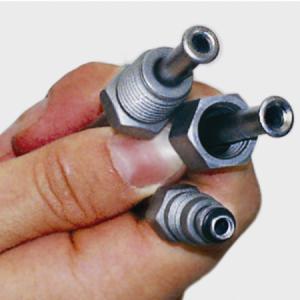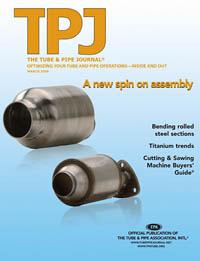- FMA
- The Fabricator
- FABTECH
- Canadian Metalworking
Categories
- Additive Manufacturing
- Aluminum Welding
- Arc Welding
- Assembly and Joining
- Automation and Robotics
- Bending and Forming
- Consumables
- Cutting and Weld Prep
- Electric Vehicles
- En Español
- Finishing
- Hydroforming
- Laser Cutting
- Laser Welding
- Machining
- Manufacturing Software
- Materials Handling
- Metals/Materials
- Oxyfuel Cutting
- Plasma Cutting
- Power Tools
- Punching and Other Holemaking
- Roll Forming
- Safety
- Sawing
- Shearing
- Shop Management
- Testing and Measuring
- Tube and Pipe Fabrication
- Tube and Pipe Production
- Waterjet Cutting
Industry Directory
Webcasts
Podcasts
FAB 40
Advertise
Subscribe
Account Login
Search
Putting a few end forming basics to work
Understanding the forming action, friction, lubrication
- By George Winton
- March 9, 2009
- Article
- Roll Forming
End forming processes are used to change the shape of a significant majority of fabricated tube ends. Quite often one or both tube ends must be formed to mate to another part. The mating part might be another tube, a small component such as a fuel pump, or a large component such as an engine block.
Forming a specific shape takes planning. An understanding of a few basics during the planning stage can go a long way.
Ram End Forming
One of the most common types of end forming machine is a ram-type end former. Usually the machine holds the workpiece stationary in a set of clamp dies while a hydraulic or pneumatic ram advances; a tool secured to the ram forms the tube's end (see Figure 1). A simple example is forming a bead. One application maintains the tube end's diameter; another reduces it.
Maintaining the OD. When the forming tool contacts the workpiece, the ram tool causes the tubing to cold-flow. The flow path is the path of least resistance. In this application, beading, the ram tool holds the tube end captive and compresses it as it forces it toward the clamp dies. The unsupported section of the tube—in the area between the clamps and the ram tool—buckles under the compressive loading, forming the bead.
In this particular case, the tooling's surface finish is not that critical to making the end form successfully. Likewise, lubricant in this case is not critical.
Reducing the OD. A setup that forms a bead and reduces the OD is similar to the one shown in Figure 1. The only difference is the shape of the forming tool. Its ID decreases; this feature forms the tube's OD, so it too decreases during the forming process (see Figure 2).
In this case, the ram tool performs more work than it did in Figure 1. Moreover, the surface finish and lubricant are critical for product quality.
Surface Finish, Lubricants, and Coatings
As the tool advances onto the tube, the tube first necks down. Long-term success for this application depends on a smooth interface between the workpiece and the tooling.
How smooth is smooth enough" One way to quantify smoothness is root mean square (RMS), a mathematical average, or mean, of the high and low points—peaks and valleys—on the surface. For example, a mirror typically has a smoothness of 4 RMS; a magazine cover is around 16 RMS; a business card about 32 RMS.
For this job, a finish of 32 RMS is too rough. The outcome would be considered a serrated finish and most likely would produce inconsistent results.
Surface finish isn't the only consideration. In fact, even if the tool's surface finish is acceptable, it can quickly come to an early demise if it isn't properly lubricated. As the ram tool necks down the tube, the process develops an enormous amount of friction between the tube and the tool's bore. If the lubricant is applied inconsistently, the process and results will be inconsistent.
A coating can extend the tool's life. Typically applied to heat-treated steels, the coating extends the tool's life by increasing its surface hardness (see Figure 3).
About the Author

George Winton
3644 Burnette Road
Suwanee, GA 30024
888-321-1499
About the Publication
subscribe now

The Tube and Pipe Journal became the first magazine dedicated to serving the metal tube and pipe industry in 1990. Today, it remains the only North American publication devoted to this industry, and it has become the most trusted source of information for tube and pipe professionals.
start your free subscription- Stay connected from anywhere

Easily access valuable industry resources now with full access to the digital edition of The Fabricator.

Easily access valuable industry resources now with full access to the digital edition of The Welder.

Easily access valuable industry resources now with full access to the digital edition of The Tube and Pipe Journal.
- Podcasting
- Podcast:
- The Fabricator Podcast
- Published:
- 04/16/2024
- Running Time:
- 63:29
In this episode of The Fabricator Podcast, Caleb Chamberlain, co-founder and CEO of OSH Cut, discusses his company’s...
- Trending Articles
Team Industries names director of advanced technology and manufacturing

Orbital tube welding webinar to be held April 23

Push-feeding saw station cuts nonferrous metals

Corrosion-inhibiting coating can be peeled off after use

3D laser tube cutting system available in 3, 4, or 5 kW

- Industry Events
16th Annual Safety Conference
- April 30 - May 1, 2024
- Elgin,
Pipe and Tube Conference
- May 21 - 22, 2024
- Omaha, NE
World-Class Roll Forming Workshop
- June 5 - 6, 2024
- Louisville, KY
Advanced Laser Application Workshop
- June 25 - 27, 2024
- Novi, MI



























